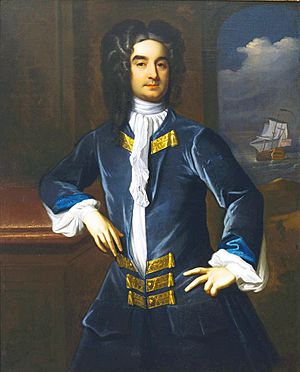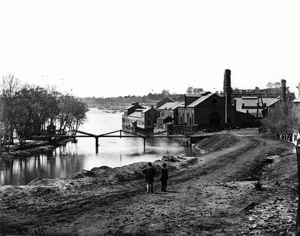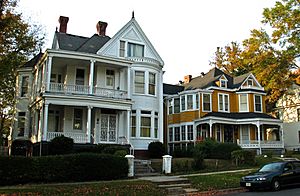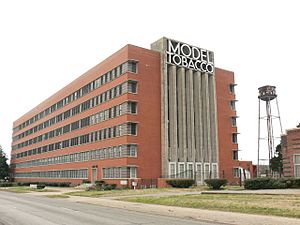History of Richmond, Virginia facts for kids
The history of Richmond, Virginia, is very important to the story of Virginia and the United States. This modern city began in the early 1600s. Richmond played a big role in the American Revolutionary War and the American Civil War. After the Civil War, Richmond grew into a strong city. Its location by the James River helped it become a center for trade and transportation.
Contents
Richmond's Early Days: The 1600s
Long before English settlers arrived, the Powhatan tribe lived near the James River falls. Their leader, Parahunt, had his main village there. This village was also called Powhatan or Shocquohocan.
In 1607, English explorers led by Christopher Newport found this important Native American site. They learned about the Powhatan people and their neighbors, the Monocan tribe. Newport was very interested in the area. He even put up a cross to claim the land for England, though he told the natives it meant friendship.
The English tried to settle near the falls several times. In 1609, Captain John Smith bought the Powhatan village. He renamed it Nonsuch. But the Powhatan people fought back, and the settlers had to leave. Later, in 1646, after more fighting, the Powhatan tribes signed a peace treaty. They gave the English land up to the James River falls. The English then built Fort Charles there.
In 1673, William Byrd I was given land that included the future site of Richmond. He was a trader and set up a fort. His son, William Byrd II, inherited this land in 1704.
Richmond in the 1700s

In the early 1700s, the area was still small. But in 1730, a law about tobacco grading helped the area grow. In 1737, William Mayo designed the first streets for Richmond. This land was given by William Byrd II. The city was named after Richmond, England.
In 1741, Henrico Parish Church was built. It is the oldest church in the city. Richmond officially became a town in 1742. By 1768, William Byrd III sold off much of the family land. This helped more people move to the Richmond area.
Richmond and the Revolutionary War
In 1775, Patrick Henry gave his famous “Give me Liberty or Give me Death” speech at St. John's Church. This speech helped convince Virginia to join the American Revolutionary War.
In 1780, Richmond became the capital of Virginia. But in 1781, British troops led by Benedict Arnold burned Richmond. The city quickly recovered. In May 1782, Richmond became a city.
After the war, the James River and Kanawha Canal was planned. George Washington was its honorary president. The cornerstone for the Virginia State Capitol, designed by Thomas Jefferson, was laid in 1785. These projects helped Richmond's economy grow. The first bridge across the James River, Mayo’s Bridge, was built in 1787.
An important law, the Virginia Statute for Religious Freedom, was passed in Richmond in 1786. It was written by Thomas Jefferson. This law protects religious freedom for everyone.
Richmond in the 1800s
Before the Civil War: 1800-1860
Slavery was a major part of Richmond's economy. Shockoe Bottom was a big center for slave trading. Many enslaved people were sent from here to the Deep South. In 1800, a large slave uprising, Gabriel Prosser's Rebellion, was planned near Richmond. It was stopped before it could begin. By 1800, Richmond's population was about 5,730 people.
Richmond saw other important changes. The city's first bank opened in 1804. The first public library started in 1806. Stagecoach lines and steamboat services began in the 1810s. The first City Hall was built in 1816.
Richmond's Industrial Growth

The Industrial Revolution came to Richmond in the 1830s. The Chesterfield Railroad opened in 1831. It carried coal from mines south of the city. In 1833, Rhys Davies helped build iron factories. By 1837, these became Tredegar Iron Works. It was the largest factory in the South.
The first steam train service started in 1836. More railroads followed, connecting Richmond to other cities. The Medical College of Virginia was founded in 1838. Richmond also became a center for newspapers and book publishers.
In 1848, Henry "Box" Brown famously escaped slavery. He mailed himself in a box from Richmond to Philadelphia, Pennsylvania, to gain his freedom.
The Civil War Years: 1861-1865
In 1861, the American Civil War began. Virginia joined the Confederate States of America. Richmond became the capital of the Confederacy. The Tredegar Iron Works was very important. It made many weapons and armor for the Confederate army. For example, it made the armor for the CSS Virginia, the world’s first ironclad warship.
In 1862, Union General George B. McClellan tried to capture Richmond. This was called the Peninsula Campaign. Confederate forces, led by General Robert E. Lee, defended the city. They used clever tactics and strong defenses. McClellan's army retreated, and Richmond remained safe for the Confederacy. This failure meant the war continued for almost three more years.
On April 2, 1863, a large "bread riot" happened in Richmond. Women protested high food prices and broke into stores.
In April 1865, Union General Ulysses S. Grant captured nearby Petersburg. Confederate President Jefferson Davis and his government left Richmond. Retreating Confederate soldiers set fires to bridges and warehouses. The fires spread and destroyed much of the city.
On April 4, 1865, President Abraham Lincoln visited the fallen city. He walked through the streets and saw the damage. Lincoln wanted to treat the defeated Confederates kindly. However, after Lincoln was assassinated a week later, the North dealt more harshly with the Southern states.
Richmond slowly began to rebuild.
After the War: Reconstruction and Growth (1865-1880)
In 1865, slavery was abolished by the Thirteenth Amendment to the United States Constitution. Richmond began its period of Reconstruction. The Theological School for Freedmen, which later became Virginia Union University, was founded for African Americans.
In 1866, the first organized Memorial Day was celebrated in Richmond. In 1869, the city started its public school system, which was segregated. Black voters participated in the city's first election since the war. In 1870, Virginia rejoined the Union.
1870 was a difficult year for Richmond. A major flood occurred. The third floor of the Virginia State Capitol collapsed, killing 60 people. Robert E. Lee also died that year.
Richmond High School opened in 1873. Cigarette manufacturing began in 1874, making tobacco even more important to the city's economy. By 1877, Reconstruction ended.
New Developments: 1880-1900
By 1880, Richmond's population reached 60,600. Monument Avenue was laid out in 1890. Over time, statues honoring Confederate heroes were placed there. Later, a statue of Richmond native and tennis star Arthur Ashe was added in 1996.
Richmond had the first successful electric trolley system in the United States. It opened in 1888. This new technology helped Richmond grow. Electric streetcars allowed new neighborhoods, called streetcar suburbs, to develop. These included Highland Park and Ginter Park.
In 1894, a new City Hall was built. It is now called the "Old City Hall". In 1896, the Supreme Court of the United States ruled in Plessy v. Ferguson that "separate but equal" laws were legal. This meant racial segregation continued.
Richmond in the 1900s
By 1900, Richmond's population was 85,050. The city saw many new theaters and opera houses built.
In 1903, Maggie L. Walker, an African-American businesswoman, started St. Luke Penny Savings Bank. She was the first woman in the U.S. to be a bank president. This bank is still around today.
Richmond and Manchester Join Forces
For over 250 years, Richmond and Manchester were separate cities. They were divided by the James River. In 1910, Manchester joined Richmond. This made Richmond a larger city. The agreement included keeping a "free bridge" over the James River.
The Roaring Twenties and Beyond
In 1914, Richmond became the headquarters for the Fifth District of the Federal Reserve Bank. This showed Richmond's importance as a financial center.
After World War I, Philip Morris tobacco company was established in Richmond in 1919. In 1925, the first radio station, WRVA, began broadcasting.
Richmond's entertainment scene grew in the 1920s. The Mosque (now Altria Theater) was built in 1926. Loew's Theater (now Carpenter Center) opened in 1927. The Byrd Theater was built in 1928 and still shows movies today.
In 1926, the Carillon was built in Byrd Park to honor those who died in World War I. In 1927, Byrd Airfield (now Richmond International Airport) opened. It was named after explorer Richard E. Byrd.
Great Depression and World War II
The tobacco industry helped Richmond recover from the Great Depression. By 1936, the city's population grew to over 255,000. Many businesses moved to Richmond. By the end of World War II in 1945, Richmond was a major shipping point for war supplies. In 1946, Richmond was one of the fastest-growing industrial centers in the U.S.
Post-War Richmond: 1945-1960
In 1948, Oliver Hill became the first black person elected to Richmond's city council since Reconstruction. Also in 1948, WTVR-TV, the South's first television station, began broadcasting in Richmond.

After World War II, cars became more popular. Streetcars were replaced by buses. To handle growing traffic, the Richmond-Petersburg Turnpike was built. It opened in 1958 and became part of Interstate 95.
Modern Richmond: 1960-2000
In the early 1960s, Richmond saw a "downtown boom." Many new buildings were constructed. In 1968, Virginia Commonwealth University was created by combining two colleges.
Richmond experienced severe flooding in 1972 from Hurricane Agnes. This caused the James River to rise very high.
In 1984, the Diamond ballpark was built for the Richmond Braves baseball team. In 1985, the 6th Street Marketplace opened downtown. It was meant to help the city center, but it eventually closed in 2004.
In 1990, L. Douglas Wilder, a Richmond native and grandson of slaves, became Governor of Virginia. He was the first elected African-American governor in U.S. history.
A large floodwall was finished in 1995 to protect downtown from the James River. Also in 1995, a statue of tennis star Arthur Ashe was added to Monument Avenue. This showed how the city was changing.
Richmond in the 2000s
2000-Present Day
By the early 2000s, the Richmond area's population was about 1.1 million. The city itself had less than 200,000 people.
The downtown floodwall was expanded. This led to new developments along the James River, including the Canal Walk. This area now has apartments, restaurants, and shops. The National Park Service opened a Civil War Visitor Center at the historic Tredegar Iron Works. Virginia Commonwealth University also expanded its campuses downtown.
In 2002, the new, larger Greater Richmond Convention Center opened. It is the biggest in Virginia. The historic Jackson Ward neighborhood is also being revitalized. It was once called "Black Wall Street" and the "Harlem of the South."
In 2003 and 2004, Richmond faced strong storms. Hurricane Isabel caused power outages in 2003. In 2004, Tropical Storm Gaston brought heavy rain and severe flooding to Shockoe Bottom. The area has since recovered.
On November 2, 2004, L. Douglas Wilder was elected Richmond's first directly-elected mayor in over 60 years.
In 2008, the Richmond Braves baseball team left Richmond. They were replaced in 2010 by the Richmond Flying Squirrels.
In the 2010 census, Richmond's population grew for the first time in 40 years. This was due to new developments and people moving back into neighborhoods like The Fan, Church Hill, and Jackson Ward.
Images for kids















